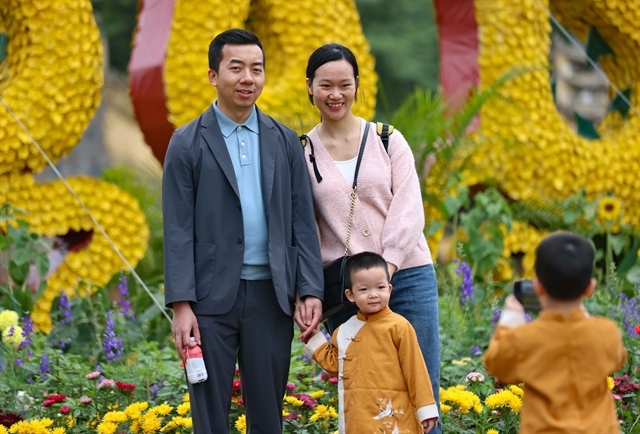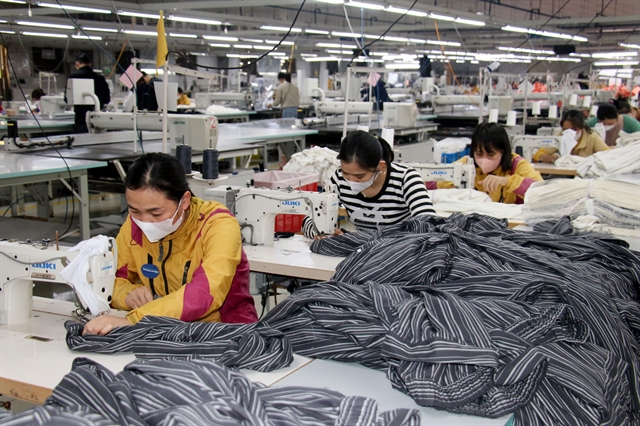 Expat Corner
Expat Corner


|
| A family consisting of parents and two children has become less common for many young couples in Việt Nam. VNA/VNS Photo Thanh Tùng |
Ray Riches*
A decade ago, I stood in the sweaty, bustling ward of a hospital in HCM City and looked down at the perfect little angel who had just arrived into the world. Her name would be Sóc, and she has forever held a special place in my heart. But Sóc is becoming a rare part of Việt Nam’s future, as birth rates continue to decline, especially in urban areas.
On the other hand, many older foreigners are looking to move to Việt Nam to enjoy their retirement years. Pending changes to visa regulations, the so-called 'Golden Visa' has excited many, as their dream of living in Việt Nam may soon become a reality.
Sóc is now nine years old and has one younger brother. This is far from the norm in Việt Nam, where couples increasingly prefer to have only one child — or none at all. In fact, the birth rate in Việt Nam is at an all-time low, posing a real challenge for the country’s future economy.
Looking at the broader picture, Việt Nam — due to its war-torn history — has a lower-than-average number of elderly people (over 65). With an estimated two to three million deaths during the war, the population was significantly impacted, resulting in one of the youngest average ages globally over the past 50 years.

|
| Caring for an elderly person at Tâm An Nursing Home in Thủ Đức City. VNA/VNS Photo |
Those who lived through the war years, particularly post-World War II to the mid 1970s, commonly had four or five children. Couples marrying in the 1970s and 1980s typically had two or three. Today, that number has dropped to around 1.9. In real terms, there has been a 45 per cent decline in the 25 years since 2000.
Yet, the population continues to grow. This is the paradox of Việt Nam. The exceptionally low number of elderly people means the death rate is also low compared to other countries. As a result, the low birth rate is still enough to sustain — and even slightly grow — the population.
Net migration in Việt Nam is consistently negative, with more Vietnamese leaving the country than entering it to live. Additionally, immigration policies — common across many Asian countries — mean that population growth through immigration is very low.
Still, the population has grown from 87 million in 2010 to 101 million in 2025. However, the net increase in the past year was just 600,000. This figure is heavily influenced by the low number of deaths among the elderly, making it somewhat artificially high.
Looking ahead, families that had four or five children between 1945 and 1975 are now ageing. These larger generations are entering the stage of life where mortality increases, meaning Việt Nam’s death rate is expected to rise significantly over the next 20 years and beyond as a higher number of people reach this age group.

|
| An older man running for exercise. Due to its war-torn history, Việt Nam has a lower-than-average number of people over 65. VNS Photo Đoàn Tùng |
That net population growth of 600,000 may soon turn negative unless younger generations begin having more children or immigration increases.
This is where retirees come into the picture. If foreigners are allowed to stay in Việt Nam long-term, they could help fill the homes and apartments left behind by older Vietnamese nearing the end of life. This is not related to net population, but more about the economy.
The reality is that young Vietnamese are moving to cities in pursuit of higher incomes. Regional centres and rural areas are experiencing significant population declines, as the best education and job opportunities are concentrated in major urban hubs.
There are now stories of older Vietnamese abandoning small farms that are too small to attract corporate buyers and too remote to appeal to locals. Their children, having studied in the cities, now work for big companies and have no interest in returning. With no buyers, the elderly simply walk away from their farms, relocating closer to medical services and relying on financial support from their children, who often earn 10 to 20 times what their parents did.
There’s a lot to unpack here. But the shifting population dynamics offer a unique opportunity: foreign retirees could become an economic lifeline for regional Việt Nam.

|
| Elderly people exercise in Hà Nội's Thống Nhất Park. VNS Photo Đoàn Tùng |
Retirees from abroad typically don’t want to live in bustling cities like HCM City or Hà Nội. They seek a quieter life, and cities like Vũng Tàu, Quy Nhơn and Hội An are among the many coastal towns where foreigners are choosing to settle.
The exciting part is that these communities may grow significantly in the future. With more long-term foreign residents in regional areas, these coastal gems could benefit from a steady cash injection, encouraging some younger Vietnamese to stay in their home provinces rather than move to the big cities.
Foreign communities also often boost tourism. Retirees frequently invite family and friends to visit, promoting local tourism in new and meaningful ways. It’s a win-win situation that could positively impact GDP, even as the overall population begins to decline.
And that’s the bottom line. Like all nations, Việt Nam faces the challenge of maintaining positive GDP growth. The past decade has seen tremendous economic expansion, and this momentum must continue through smart planning and careful management of the population.
Global brands increasingly choose Việt Nam as a manufacturing hub. While current issues with the US are challenging, there are signs that Việt Nam may emerge stronger than many of its Southeast Asian neighbours.
Of course, the elephant in the room is the birth rate. How can any country encourage young people to have more children? Across the Western world — and in nearby countries like South Korea and Japan — this issue has become a major concern, with serious implications for domestic GDP.
Some countries, like Australia, have long relied on skilled migration to address labour shortages and support population growth. But this isn’t a one-size-fits-all solution. Japan, for example, has resisted large-scale immigration as a strategy for future development.
Ultimately, two key factors place Việt Nam in a uniquely strong — albeit challenging — position. First, decades of economic growth have left the country in better shape than many others. Second, Việt Nam’s strong leadership means that the tough decisions and planning required for the future will likely be made with the country’s best interests in mind, even if they bring significant changes.
I believe that in the near future, Vietnam’s population may dip below 100 million. But this won’t have a major impact on daily life. With both short- and long-term plans already in motion, the country is well positioned to manage these challenges and ensure that communities continue to thrive — just with fewer children than a generation ago.
This is a global issue, and many countries are in a far worse position than Việt Nam. I truly believe that Việt Nam and Japan will become textbook examples of population management over the next 100 years. Let’s see how it goes. VNS
*Ray Riches lives in HCM City and works as a teacher and freelancer. Apart from teaching, he is a keen runner and bicycle adventure rider. After ten years in Việt Nam, Ray has a love and passion for the smaller things and enjoys sharing his experiences with people all over the world.









